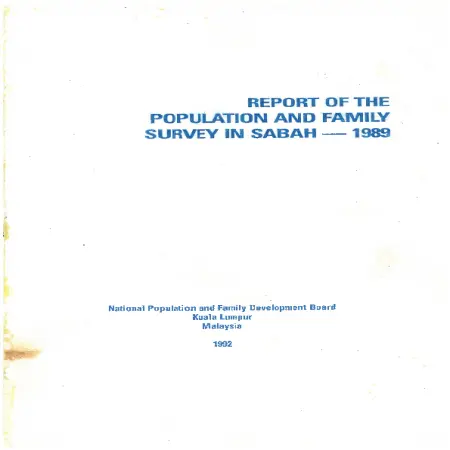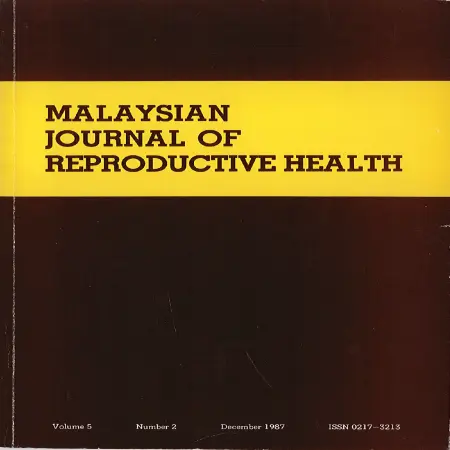TOPICS
Results for Topics : "Contraception"
|
|
Kontraseptif kecemasan: kesedaran dan penggunaannya
Item Type: Conference or Workshop Item
Editor:
Year: 00/00/2012
Abstract: Emergency contraceptive (EC) is one of the methods of contraception used after unprotected sex. With proper use, this method of emergency contraception can help reduce the problems of unplanned or unwanted pregnancies that have been frequent in recent times. The objective of this study was to identify women’s awareness of emergency contraceptive methods and their level of use. The research method involved the distribution of questionnaires to 1000 women, aged 15 to 49 years, who attended programs organized by NPFDB. Data collection and analysis was carried out using SPSS 11.5 software. The chi -square test was used to study the relationship between the sociodemographics of the respondents and the variables studied. The coverage of the study consisted of 84% Malay women, and was followed by Indians (9%) and Chinese (6%). The majority of respondents (43%) were in the range of 25 to 34 years, with a mean age of 33 years. Contraceptive use among respondents was found to be 26.3%, of which 98% were married women. The study found that women’s awareness of EC and its level of use was low, being only 29% and 3.9%, respectively. The chi -square test results showed that the level of awareness of EC increased with age (p <0.05). In addition, more highly educated women were found to have heard of EC (p <0.05) compared to low levels. Most EC users are from the married group. Nearly 70% of women who are using contraceptives are found to have used EC. Among women who have never used EC, only 21% are interested in using it in the future. However, the majority (70%) support this service provided at NPFDB. The lack of exposure on EC results in the number of women interested in using it being low. Therefore, NPFDB and related parties need to enhance promotional activities, advocacy and learning of emergency contraceptive methods, in addition to other methods, so that the community knows about it and can use it during emergencies.
|
|
|
|
|
|
Report of the Population and Family Survey in Sarawak - 1989
Item Type: Research Report
Editor:
Year: 00/00/1992
Abstract: The main objective of the Population and Family Survey in Sarawak was to provide necessary data for the formulation, implementation and evaluation of population and family development programmes, in line with national objectives. Specifically, the survey was conducted to collect information on socio-cultural determinants of fertility and maternity patterns, fertility preferences and behaviour, female labour force participation, childcare arrangement, family life, family planning practices, socio-economic status of subgroups, as well as population profiles and migratory patterns.
|
|
|
|
|
|
Report of The Population and Family Survey in Sabah - 1989
Item Type: Research Report
Editor:
Year: 00/00/1992
Abstract: The main objective of the survey was to provide necessary data for the formulation, implementation and evaluation of population and family development programmes, in line with national objectives. Specifically, the survey was conducted to collect information on socio-cultural determinants of fertility and maternity patterns, fertility preferences and behaviour, female labour force participation, childcare arrangement, family life, family planning practices, socio-economic status of subgroups, as well as population profiles and migration patterns.
|
|
|
|
|
|
Coagulation profile in women on low-dose oral contraceptive pills
Item Type: Article
Editor:
Year: 00/12/1990
Abstract: A cross-sectional study looking at the coagulation system was carried out involving 175 women attending the National Population and Family Development Board's Clinic at the Maternity Clinic, General Hospital, Kuala Lumpur. Study subjects comprise of 50 combined low-dose estrogen/progesterone oral contraceptive (OC) pill users and 75 non-OC users, acting as controls. The subjects were on the pill for a period of one year or more. There were significant shortening of the prothrombin time (PT) and partial thromboplastin time (PTT) in the OC group as compared to the control group. However, the activities of factors II, V and VII assayed were not significantly different between the two groups, suggesting that the changes in the PT and PTT were not significant clinically. The effect of long term usage of combined low-dose OC pills does not seem to indicate changes in the coagulation profile of the women in our study.
|
|
|
|
|
|
Comparative study on the acceptance and use of contraceptive methods in a rural population in Kelantan
Item Type: Article
Editor:
Year: 00/12/1990
Abstract: The generally poor health indices for Kelantan and the strong cultural beliefs with reference to contraception dictated the need for this study. 350 women from neighbouring estates were studied via questionaires. It was found that only 44.85% use some form of contraception and 18.4% of these resorted to traditional methods. There was some relationship between race and choice of contraception. Education did play a role in encouraging contraception. Despite the low acceptance of contraception, spacing of children did exist-probably due to breastfeeding that's widely practised.
|
|
|
|
|
|
K.A.P. Study of Family planning among married Orang Asli Women of Hulu Langat District, Selangor Darul Ehsan, Malaysia
Item Type: Article
Editor:
Year: 00/00/1990
Abstract: A study of knowledge, attitude and practice was carried out among sixty nine married Orang Asli women in the district of Kuala Langat. The study showed that only a small proportion of the women were using family planning methods. About half of the study women were still uncertain with regards to their attitude towards family planning. The findings also showed that there was no diversity of the methods with oral contraceptive being the major choice. Majority of the husbands had indeed positive feeling towards family planning. The women also considered breastfeeding as a major method of contraception.
|
|
|
|
|
|
Hemorrheology and fibrinolytic response in women taking oral contraceptive pills
Item Type: Article
Editor:
Year: 00/12/1987
Abstract: A study was conducted on a total of 107 women attending the National Population and Family Development Board, Malaysia (NPFDB) Maternity Hospital, Kuala Lumpur. The subjects were divided into 3 groups. Group I and II consisted of woman on a low-dose combined estrogen and progestagen pills for a duration of 3-6 months and 1-2 year respectively. Group III was a control group consisting of women not on pills. A series of tests to evaluate hemorrheology and the fibrinolytic response were carried out. The results obtained showed no definite or significant difference in the two systems for all the three groups investigated. These findings are comparable to those reported by other investigators, implying relative safety of these pills in the local population.
|
|
|
|
|
|
Paramedic insertion of intrauterine device in a Malaysian family planning clinic
Item Type: Article
Editor:
Year: 00/06/1987
Abstract: A retrospective study was carried out in a Malaysian urban family planning clinic to evaluate the effectiveness of the paramedic in intrauterine contraceptive device (IUD)insertion. Seventy-nine multiload Cu 250 insertions by trained senior nurse in 1983 were measured against 369 insertions by doctors. Follow-up was done by nurses. At the cut-off date on 31st October 1985, the case records were examined. It was found that there was no statistically significant difference in termination percentage due to IUD complications. The nurse's group had a significantly higher percentage of failure to follow-up and also removal for personal reasons. No significant difference between the 2 groups was shown for termination due to accidental pregnancy, bleeding and pain, expulsion and pelvic infections. Removal of IUD to plan for pregnancy is high in both groups. The results show that the trained paramedic can be just as effective as doctors for IUD insertion.
|
|
|
|
|
|
A prospective study of the acceptability of today vaginal contraceptive sponge among Malaysian women
Item Type: Article
Editor:
Year: 00/06/1987
Abstract: Fifty volunteers were selected in a two month prospective study to evaluate the acceptability of the Today vaginal sponge contraceptive among Malaysian women. One participant developed allergic reaction to the sponge and was taken off at an early stage of the study. Fourty- nine participants completed one month follow-up.Thirteen subjects discontinued for various reasons which are related and not related to the sponge. The remaining 36 participants completed the study. Few side effects were observed among the sponge users who completed the trial. One subject complained that the Loop of the sponge hurt her husband's penis. Most of the women who are on the sponges claimed that sexual intercourse is no longer messy. Four subjects claimed that the sponges pontentiated sexual feeling to their male partners. The sponge is generally accepted by the study group, which suggest that the general impression 'Asian Women abhor any form of vaginal contraception' is not totally correct. It is suggested that the contraceptive efficacy of the sponge be evaluated among our women in the future.
|
|
|
|














